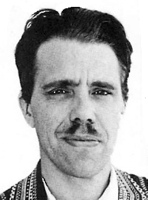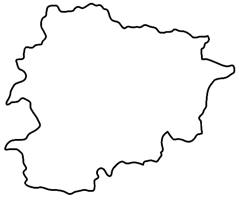
|
The Society of Folk Dance Historians (SFDH)
Andorran Dance and Music
[
Home |
About |
Encyclopedia | CLICK AN IMAGE TO ENLARGE |

|
 Dance and music, to the Andorrans, are essential parts of what it takes to make life pleasant – just as they are to the other peoples of the Iberian Peninsula and the Pyrenees – the Catalonians, Basques, Spaniards, Portuguese, and Gallegans.
Dance and music, to the Andorrans, are essential parts of what it takes to make life pleasant – just as they are to the other peoples of the Iberian Peninsula and the Pyrenees – the Catalonians, Basques, Spaniards, Portuguese, and Gallegans.
Until quite recent years, life was rugged, and left little time for amenities after the struggle to eat and provide shelter was done – hence, Andorra has produced no Beethovens, no Rembrandts, no Diors, no Moiseyevs. Thus the art, music, dances, and costumes of the land have been simple, and to some extent, borrowed from its neighbors.
The costume of Andorra is pleasantly simple. For the man, it consists of knee breeches of a durable cloth, a black velvet long-sleeved coat or jacket with a small collar, lapels, and large buttons, and perhaps a vest. His shirt is white with a small string-type tie and shoes that are of leather and quite resembling the "opanke" of Croatia. His hat is of cloth or fur with a red tassel. The whole scheme traditionally is black, but in more recent years, there have been changes to colors – but still dark and subdued, such as dark browns, blues, and greens. Oh yes, his hose are white!
The woman's dress is very attractive too – full long skirt, long-sleeved bodice, and jacket with a shawl. Decorations are minimal. The married woman may wear a hat or kerchief, but it is not mandatory. Her costume is also black or quite dark. In recent times, corduroy has become fashionable. Of course, in really recent times, Andorrans wear such as we do, and blue jeans – because of Andorra's unusual customs and tax system, are probably much easier to get than in any other European country. The black motif was not entirely one of accident or lack of availability of color. A thousand years of smuggling as the "national industry" required unobtrusive clothing, and black was an excellent camouflage crossing the French and Spanish borders at night.
Music and song of the Andorrans is quite like that of the Catalan areas of France and Spain, but not as vivid as that of say, Granada or Gallic France. Songs are often of that throaty and sometimes sad-like quality found in Barcelona. There is no particular national instrument for music – that is, no folk instrument – and the alboka hornpipe, the cornemuse, and gaita bagpipes of France and Spain, castanets, and contemporary accordions and clarinets are used for the dance music.
A small country, Andorra has few national dances. There is the old Contrapàs, the Marataxa, a Dansa, Farandoles (such as are seen in neighboring south of France), and above all the Sardanas.
Like we do, they also "count" as they go through it, changing from the corts to the llargs as they raise their hands on high. And you will see Andorrans dancing in the public squares of their towns every Saturday evening during the summer, especially of late years because Andorra has become a mecca for tourists and, as this is what tourists expect, the natives are happy to oblige.
The Sardana has been the subject of controversy indeed, in folk dance circles, because of its odd structure, odd count, and geographic range. If you want to go out of your mind, try to follow the directions given by Rickey Holden in an issue of Viltis written in 1967. Somehow though, "Sardanistas" know when to make the changes and how to do the steps, no matter what version – and one can watch them dance with their eyes closed even, hands raised on high, and an air of ecstasy in their expressions. The name implies that it may have originated in Sardinia, Which it indeed could have, for it is of undoubtedly ancient origin. As in other countries when national totems and expressions were forbidden, music was taboo for dancing at times in Catalonian areas (although Andorra was not one of those places), so the heavy stepping of the feet and singing was substituted and the dance became symbolic. There has been contention that there is only one authentic Sardana, but obviously, this is not the case. There are scores of melodies and dances to fit each. Each particular valley or village, however, has its own version, which is "the one" for that place. Thus in Andorra, the Sardana would have versions and variations (minor) in Les Escalades, Canillo, Encamp, Santa Coloma, or in the capital Andora la Vella (Andorra the Old) itself.
Folkloric celebrations are held with regularity in Andorra, and like those in Spain, are often religious in character (Andorra is strongly Roman Catholic country). Holy week celebrations, and a devout play and parade on Maundy Thursday, are occasions of popular festivities. In Canillo, there is a celebration on the third Sunday and Monday of July. Les Escaldes, near the capital city, has a fiesta and dance around the end of July for three days. In Sant Julià de Lòria, near the Spanish border, they celebrate on the last Sunday through Tuesday of July, and on November 5 as a Saint's Day festival. The capital city, Andorra la Vella, has its celebration the first weekend in August (these folkloric weekends run Saturday through Monday, and sometimes Tuesday). Encamp has its festival in mid-August, and Ordino has a two-day event in September. At all of these, the Sardana will be danced, as they are religious and/or secular holidays. Yet, Andorra has no equivalent to our Fourth of July.
To see the Andorrans dancing in their plaza, square, or in the fields against the spectacular panorama of green fields, rich valleys, and rugged mountains, in a clear, smog-free atmosphere, can be indeed a refreshing and satisfying experience.
DOCUMENT
- Andorra, a country
Printed in Folk Dance Scene, October 1978.
This page © 2018 by Ron Houston.
Please do not copy any part of this page without including this copyright notice.
Please do not copy small portions out of context.
Please do not copy large portions without permission from Ron Houston.